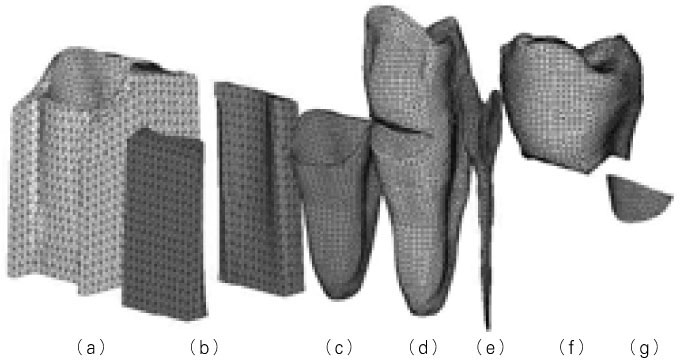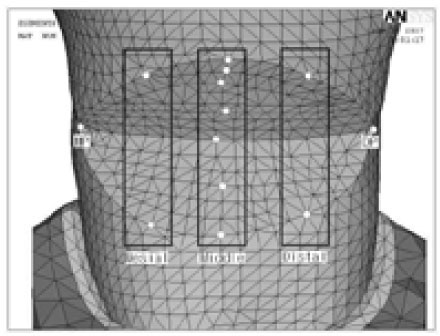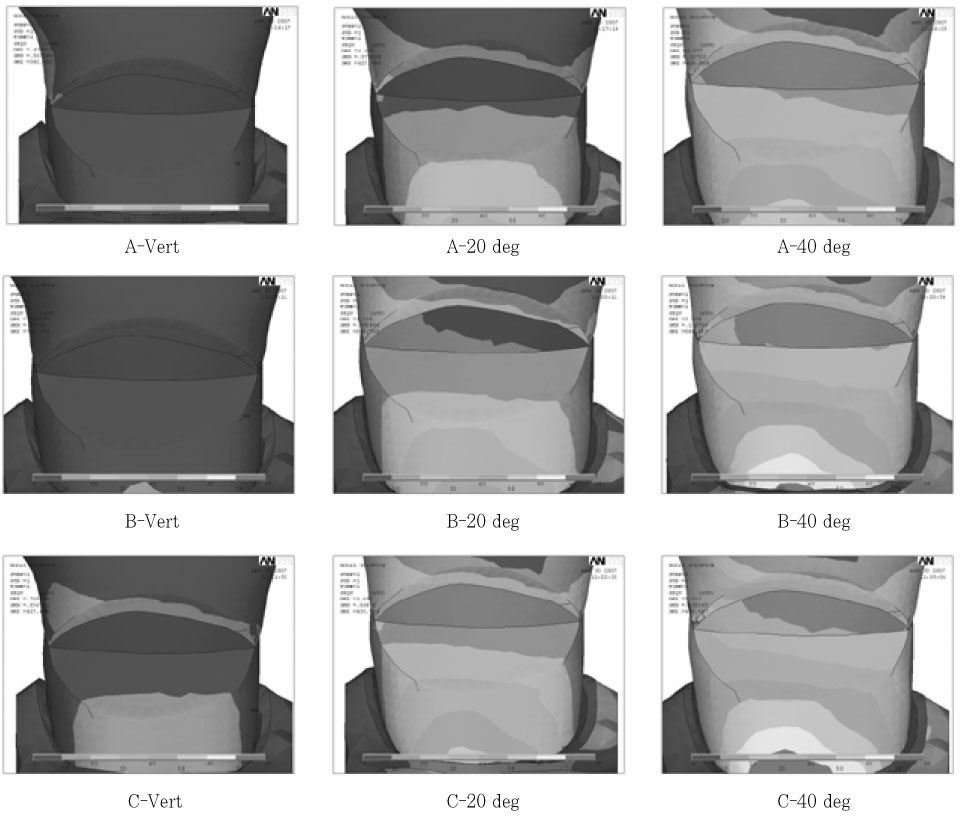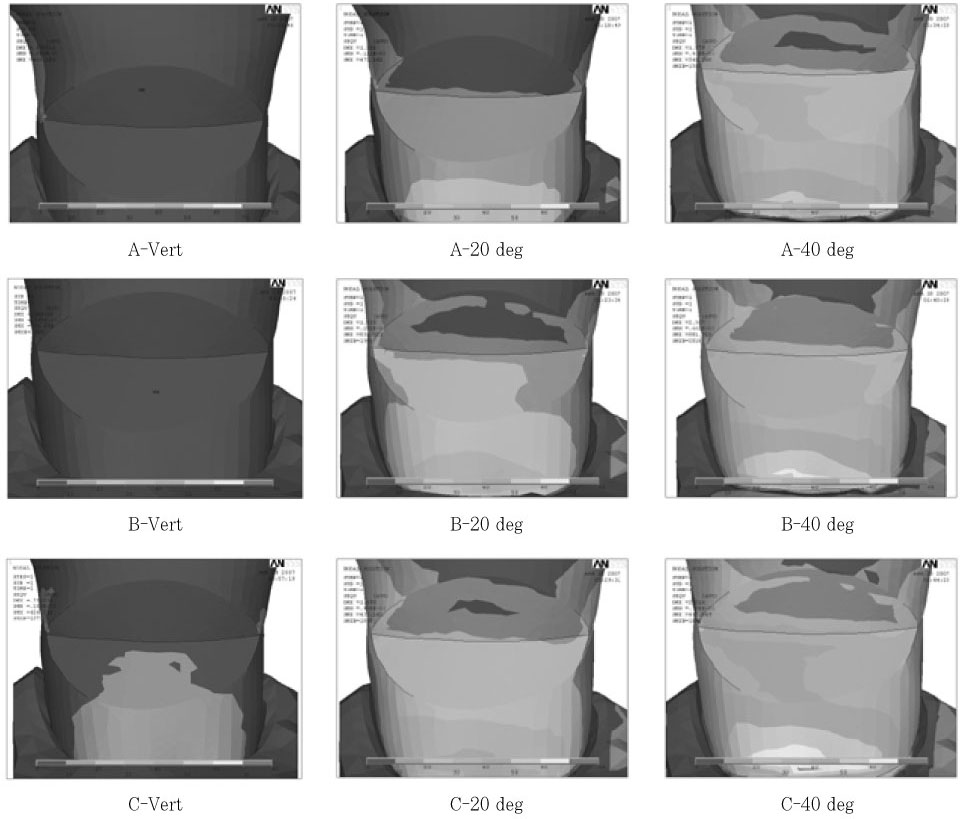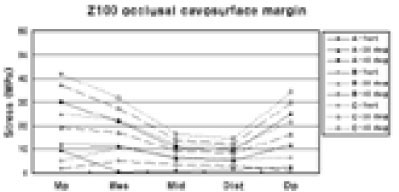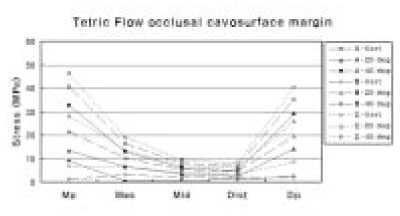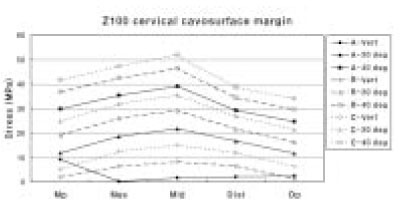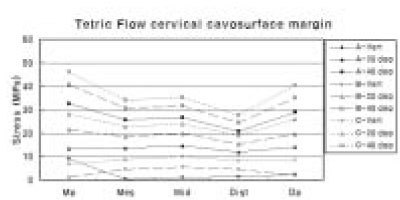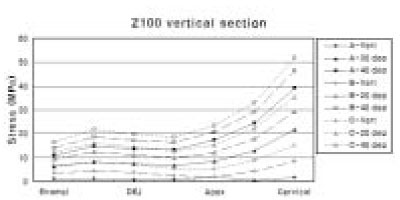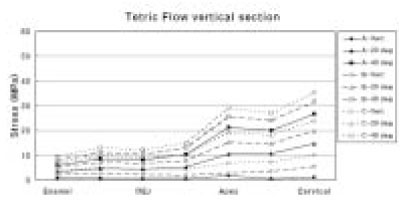J Korean Acad Conserv Dent.
2008 May;33(3):246-257. 10.5395/JKACD.2008.33.3.246.
The influence of occlusal loads on stress distribution of cervical composite resin restorations: A three-dimensional finite element study
- Affiliations
-
- 1Department of Conservative Dentistry, School of Dentistry, Pusan National University, Korea. jeongkil@pusan.ac.kr
- 2Department of Mechanical Design Engineering, College of Engineering, Pusan National University, Korea.
- KMID: 2175987
- DOI: http://doi.org/10.5395/JKACD.2008.33.3.246
Abstract
- The purpose of this study was to investigate the influence of various occlusal loading sites and directions on the stress distribution of the cervical composite resin restorations of maxillary second premolar, using 3 dimensional (3D) finite element (FE) analysis. Extracted maxillary second premolar was scanned serially with Micro-CT (SkyScan1072; SkyScan, Aartselaar, Belgium). The 3D images were processed by 3D-DOCTOR (Able Software Co., Lexington, MA, USA). HyperMesh (Altair Engineering, Inc., Troy, USA) and ANSYS (Swanson Analysis Systems, Inc., Houston, USA) was used to mesh and analyze 3D FE model. Notch shaped cavity was filled with hybrid (Z100, 3M Dental Products, St. Paul, MN, USA) or flowable resin (Tetric Flow, Vivadent Ets., FL-9494-Schaan, Liechtenstein) and each restoration was simulated with adhesive layer thickness (40 microm). A static load of 200 N was applied on the three points of the buccal incline of the palatal cusp and oriented in 20degrees increments, from vertical (long axis of the tooth) to oblique 40degrees direction towards the buccal. The maximum principal stresses in the occlusal and cervical cavosurface margin and vertical section of buccal surfaces of notch-shaped class V cavity were analyzed using ANSYS. As the angle of loading direction increased, tensile stress increased. Loading site had little effect on it. Under same loading condition, Tetric Flow showed relatively lower stress than Z100 overall, except both point angles. Loading direction and the elastic modulus of restorative material seem to be important factor on the cervical restoration.
Keyword
MeSH Terms
Figure
Cited by 1 articles
-
Finite element analysis of maxillary central incisors restored with various post-and-core applications
MinSeock Seo, WonJun Shon, WooCheol Lee, Hyun-Mi Yoo, Byeong-Hoon Cho, Seung-Ho Baek
J Korean Acad Conserv Dent. 2009;34(4):324-332. doi: 10.5395/JKACD.2009.34.4.324.
Reference
-
1. Grippo JO. Abfractions: A new classification of hard tissue lesions of tooth. J Esthet Dent. 1991. 3:14–19.2. Lee WC, Eakle WS. Stress-induced cervical lesions: Review of advances in the past 10 years. J Prosthet Dent. 1996. 75:487–494.
Article3. Telles D, Pegoraro LF, Pereira JC. Prevalence of noncarious cervical lesions and their relation to occlusal aspects: a clinical study. J Esthet Dent. 2000. 12:10–15.
Article4. Grippo JO. Tooth flexure (letter). J Am Dent Assoc. 1991. 122:13.5. Lee WC, Eakle WS. Possible role of tensile stress in etiology of cervical erosive lesions of teeth. J Prosthet Dent. 1984. 52:374–380.
Article6. Xhonga FA. Bruxism and its effect on the teeth. J Oral Rehabil. 1977. 4:65–76.
Article7. Lambrechts P, Braem M, Vanherle G. Evaluation of clinical performance for posterior composite resins and dentin adhesives. Oper Dent. 1987. 12:53–78.8. Hood JA. Experimental studies on tooth deformation: stress distribution in class V restorations. N Z Dent J. 1972. 68:116–131.9. Morin DL, Douglas WH, Cross M, Delong R. Biophysical stress analysis of restored teeth: experimental strain measurement. Dent Mater. 1988. 4:41–48.
Article10. Lee CK, Park JK, Kim HC, Woo SG, Kim KH, Son K, Hur B. The influence of composite resin restoration on the stress distribution of notch shaped noncarious cervical lesion; A three dimensional finite element analysis study. J Korean Acad Conserv Dent. 2007. 32:69–79.
Article11. King PA. Adhesive techniques. Br Dent J. 1999. 186:321–326.
Article12. Grippo JO. Noncarious cervical lesions: the decision to ignore or restore. J Esthet Dent. 1992. 4:Suppl. 55–64.
Article13. Blunck U. Improving cervical restorations: a review of materials and techniques. J Adhes Dent. 2001. 3:33–44.14. Kemp-Scholte CM, Davidson CL. Complete marginal seal of class V resin composite restorations effected by increased flexibility. J Dent Res. 1990. 69:1240–1243.
Article15. Kemp-Scholte CM, Davidson CL. Marginal integrity related to bond strength and strain capacity of composite resin restorative system. J Prosthet Dent. 1990. 64:658–664.
Article16. Van Meerbeek B, Peumans M, Gladys S, Braem M, Lambrechts P, Vanherle G. Three-year clinical effectiveness of four total-etch dentinal adhesive systems in cervical lesions. Quintessence Int. 1996. 27:775–784.17. Rees JS. The effect of variation in occlusal loading on the development of abfraction lesions: a finite element study. J Oral Rehabil. 2002. 29:188–193.
Article18. Ichim I, Schmidlin PR, Kieser JA, Swain MV. Mechanical evaluation of cervical glass-ionomer restorations: 3D finite element study. J Dent. 2007. 35:28–35.
Article19. Lee HE, Lin CL, Wang CH, Cheng CH, Chang CH. Stresses at the cervical lesions of maxillary premolar -a finite element investigation. J Dent. 2002. 30:283–290.
Article20. Borcic J, Anic I, Smojver I, Catic A, Miletic I, Ribaric SP. 3D finite element model and cervical lesion formation in normal occlusion and in malocclusion. J Oral Rehabil. 2005. 32:504–510.
Article21. Palamara D, Palamara JE, Tyas MJ, Messer HH. Strain patterns in cervical enamel of teeth subjected to occlusal loading. Dent Mater. 2000. 16:412–419.
Article22. Katona TR, Winkler MM. Stress analysis of a bulk-filled class V light-cured composite restoration. J Dent Res. 1994. 73:1470–1477.
Article23. Geramy A, Sharafoddin F. Abfraction: 3D analysis by means of the finite element method. Quintessence Int. 2003. 34:526–533.24. Lindehe J, Karring T. Textbook of Clinical Periodontology. 1989. 2nd edition. Copenhagen: Munksgaard;19–69.25. Schroeder HE, Page RC. Periodontal Diseases. 1990. 2nd edition. Philadelphia: Lea & Fabiger;3–52.26. Le SY, Chiang HC, Huang HM, Shih YH, Chen HC, Dong DR, Lin CT. Thermo-debonding mechanisms in dentin bonding systems using finite element analysis. Biomaterials. 2001. 22:113–123.
Article27. Grippo JO, Simring M. Dental "erosion" revisited. J Am Dent Assoc. 1995. 126:619–630.
Article28. Levitch LC, Bader JD, Shugars DA, Heymann HO. Non-carious cervical lesion. J Dent. 1994. 22:195–207.29. Aw TC, Lepe X, Johnson GH, Mancl L. Characteristics of non-carious cervical lesion. J Am Dent Assoc. 2002. 133:725–733.30. Widmalm SE, Ericsson SG. Maximal bite force with centric and eccentric load. J Oral Rehabil. 1982. 9:445–450.
Article31. Gibbs CH, Mahan PE, Lundeen HC, Brehnan K, Walsh EK, Holbrook WB. Occlusal forces during chewing and swallowing as measured by sound transmission. J Prosthet Dent. 1981. 46:443–449.
Article32. Nakamura T, Imanishi A, Kashima H, Ohyama T, Ishigaki S. Stress analysis of metal-free polymer crowns using the three-dimensional finite element method. Int J Prosthodont. 2001. 14:401–405.33. Yettram AL, Wright KW, Pickard HM. Finite element stress analysis of the crowns of normal and restored teeth. J Dent Res. 1976. 55:1004–1011.
Article34. Goel VK, Khera SC, Ralston JL, Chang KH. Stresses at the dentinoenamel junction of human teeth - A finite element investigation. J Prosthet Dent. 1991. 66:451–459.
Article35. Tanaka M, Naito T, Yokota M, Kohno M. Finite element analysis of the possible mechanism of cervical lesion formation by occlusal force. J Oral Rehabil. 2003. 30:60–67.
Article36. Heymann HO, Sturdevant JR, Bayne S, Wilder AD, Sluder TB, Brunson WD. Examining tooth flexure effects on cervical restorations: a two-year clinical study. J Am Dent Assoc. 1991. 122:41–47.
Article37. Xhonga FA, Wolcott RB, Sognnaes RF. Dental erosion II. Clinical measurements of dental erosion progress. J Am Dent Assoc. 1972. 84:577–582.
Article38. Heymann HO, Sturdevant JR, Brunson WD, Wilder AD, Sluder TB, Bayne SC. Twelve-month clinical study of dental adhesive in class V cervical lesions. J Am Dent Assoc. 1988. 116:179–183.
Article39. Van Meerbeek B, Peumans M, Verschueren M, Gladys S, Braem M, Lambrechts P, Vanherle G. Clinical status of ten dentin adhesive systems. J Dent Res. 1994. 73:1690–1702.
Article40. Yaman SD, Sahin M, Aydin C. Finite element analysis of strength characteristics of various resin based restorative materials in class V cavities. J Oral Rehabil. 2003. 30:630–641.
Article41. Leinfelder KF. Restoration of abfracted lesions. Compendium. 1994. 15:1396–1400.42. Braga RR, Hilton TJ, Ferracane JL. Contraction stress of flowable composite materials and their efficacy as stress-relieving layers. J Am Dent Assoc. 2003. 134:721–728.
Article
- Full Text Links
- Actions
-
Cited
- CITED
-
- Close
- Share
- Similar articles
-
- The effect of restorative materials on the stress distribution of class V composite resin restorations: a 3D finite element investigation
- The influence of combining composite resins with different elastic modulus on the stress distribution of Class V restoration: a three-dimensional finite element study
- Stress distribution of Class V composite resin restorations: A three-dimensional finite element study
- The effect of the amount of interdental spacing on the stress distribution in maxillary central incisors restored with porcelain laminate veneer and composite resin: A 3D-finite element analysis
- The influence of composite resin restoration on the stress distribution of notch shaped noncarious cervical lesion; A three dimensional finite element analysis study

